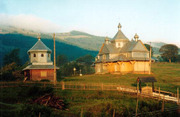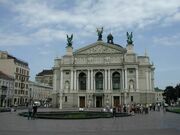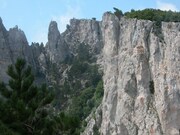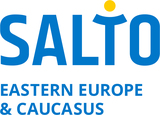Main facts about Ukraine
Official Name:
Ukraine | Україна
Capital:
Kyiv
Politics of Russia:
With the proclamation of its independence on 24 August 1991, and adoption of a constitution on 28 June 1996, Ukraine became a semi-presidential republic. However, in 2004, deputies introduced changes to the Constitution, which tipped the balance of power in favour of a parliamentary system. From 2004 to 2010, the legitimacy of the 2004 Constitutional amendments had official sanction, both with the Constitutional Court of Ukraine, and most major political parties.[246] Despite this, on 30 September 2010 the Constitutional Court ruled that the amendments were null and void, forcing a return to the terms of the 1996 Constitution and again making Ukraine's political system more presidential in character.
 The Flag:
The Flag:
The flag of Ukraine is a banner of two equally sized horizontal bands of blue and yellow (Constitution of Ukraine, Article 20). The combination of blue and yellow as a symbol of Ukrainian lands comes from the flag of the Kingdom of Galicia–Volhynia used in the 12th century. As a national flag, the blue and yellow bicolour has been officially used since the 1848 Spring of Nations, when it was hoisted over the Lviv Rathaus. It was officially adopted as a state flag for the first time in 1918 by the short-lived West Ukrainian People's Republic and subsequently used by the Ukrainian People's Republic. When Ukraine was part of the Soviet Union, the flag was outlawed and, before 1949, there was no official state flag until adoption of the red-azure flag of the Ukrainian SSR. The blue and yellow flag was provisionally adopted for official ceremonies in September 1991 following Ukrainian independence, before finally officially being restored on 28 January 1992 by the parliament of Ukraine.
 The Coat of Arms:
The Coat of Arms:
The coat of arms of Ukraine is a blue shield with a gold trident. Officially referred to as the Princely State Symbol of Volodymyr the Great, or, colloquially, the tryzub, the insignia derives from the seal-trident of Volodymyr, the Grand Prince of Kyiv.
The Anthem:
"Shche ne Vmerla Ukrainy i slava, i volia" (Ukrainian: Ще не вмерла України і слава, і воля, pronounced [ˈʃtʃɛ nɛ ˈu̯mɛrlɐ ʊkrɐˈjinɪ i ˈslɑwɐ i ˈwɔlʲɐ], lit. 'Glory and Freedom of Ukraine Has not yet Perished'), also known by its official title of "State Anthem of Ukraine" (Державний Гімн України, Derzhavnyi Himn Ukrainy) or by its shortened form "Shche ne vmerla Ukrainy" (Ще не вмерла України), is the national anthem of Ukraine. Its music was officially adopted by Ukraine's Verkhovna Rada on 15 January 1992. The official lyrics were adopted on 6 March 2003 by the Law on the Anthem of Ukraine (Закон про Гімн України).
The Constitution:
The Constitution of Ukraine (Ukrainian: Конституція України) is the fundamental law of Ukraine. The constitution was adopted and ratified at the 5th session of the Verkhovna Rada (parliament) of Ukraine on June 28, 1996.[1] The constitution was passed with 315 ayes out of 450 votes possible (300 ayes minimum).[
Read more about the general information about Ukraine HERE
Media:
The mass media in Ukraine refers to mass media outlets based in Ukraine. Television, magazines, and newspapers are all operated by both state-owned and for-profit corporations which depend on advertising, subscription, and other sales-related revenues. The Constitution of Ukraine guarantees freedom of speech. As a country in transition, Ukraine's media system is under transformation.
Read more about the Media and Censorship in Ukraine HERE
 Greek Catholic Church
Greek Catholic Church Lviv Opera and Ballet Theatre
Lviv Opera and Ballet Theatre Crimean Mountains
Crimean Mountains Kamianets Podilskyj Castle
Kamianets Podilskyj Castle
